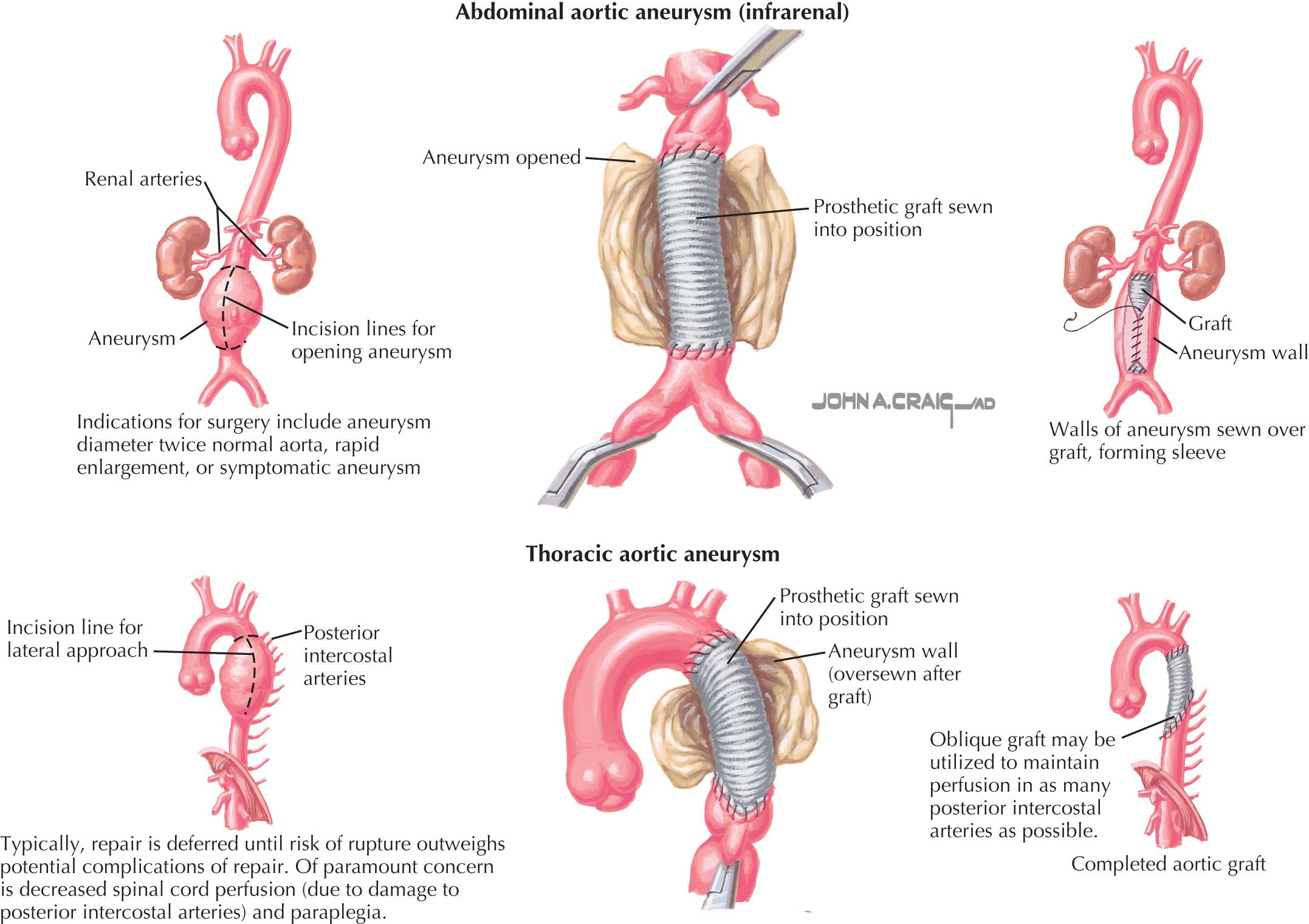Physical Address
304 North Cardinal St.
Dorchester Center, MA 02124
There is a wide spectrum of diseases that can affect the aorta. Aneurysmal disease is the second most frequent disease of the aorta after atherosclerosis. The most common location for aneurysmal disease is the infrarenal aorta, but it can also affect the thoracic, ascending, and arch portions of the aorta, as well as the iliac vessels. Typically, aneurysmal disease is a silent pathology that is found incidentally on imaging or physical examination. Although, in the past, the etiology for aneurysmal disease was believed to be secondary to atherosclerosis, recently, it has been found to be multifactorial. Most patients are asymptomatic and undergo treatment because the aneurysm is large or increasing in size, and thus puts them at risk for rupture. Symptoms of aneurysmal aortic disease include abdominal pain, back pain, and flank pain, and portend a risk of rupture. Endovascular aneurysm repair (EVAR) of the abdominal aorta has emerged as an effective and safe approach for repair of aortic aneurysms. Alternatively, thoracic aortic disease (aneurysms, dissections, transections) can be treated with thoracic endovascular aneurysm repair with excellent results. Recently, advancement of stent technology has allowed incorporation of more complex anatomy involving the visceral and renal vessels, as well as the hypogastric and supraaortic trunk vessels.
Acute aortic syndrome (AAS) is a collection of pathologies that includes acute aortic dissection, aortic rupture, intramural hematoma, and penetrating atherosclerotic ulcer. These entities have a high morbidity and mortality, and require immediate recognition and management to improve outcomes. Aortic transection from blunt aortic injury has seen an improvement in patient outcomes with the introduction of endovascular techniques for repair.
There are also a variety of less common aortic pathologies, such as vasculitis, inflammatory and/or mycotic aneurysms, and connective tissue diseases. Takayasu disease and giant cell arteritis are two large vessel vasculitides that involve the aorta and major branch vessels. Inflammatory and/or mycotic aneurysms are rare causes of aneurysms, but require recognition for proper treatment and correct surgical repair. Ultimately, care must be taken to identify genetic disorders such as connective tissue diseases as potential causes for aneurysms, because incorrect diagnosis can lead to an increase in morbidity and mortality.
This chapter provides a review of the various aortic pathologies, with an evaluation of the epidemiology, pathophysiology, diagnosis, and treatment options.
Aneurysmal disease usually involves large arteries, most commonly, the infrarenal aorta and iliac arteries, and it less often involves other major arteries, including the thoracic aorta and the femoral and popliteal arteries ( Figs. 62.1 and 62.2 ). Although small aneurysms have been reported to rupture, the risk of rupture is believed to rise exponentially with an increasing diameter, according to Laplace law—that the greater the radius of an artery, the greater the tension on the arterial wall. Atherosclerosis is an important contributor to aneurysmal dilatation as are hypertension and tobacco use, with up to one-third of patients having a genetic predisposition for aneurysmal disease.


For many years, the etiology of aneurysmal disease was believed to be primarily related to atherosclerosis, largely because aneurysmal disease occurs predominantly in older adult hypertensive individuals and is associated with tobacco use. The etiology is now believed to be multifactorial. Genetic predisposition may be involved in up to one-third of patients with aneurysms. Microscopic analysis indicates that deficiencies in elastin, collagen, or both, may be crucial factors. Collagen-degrading matrix metalloproteinases are probable culprits in aneurysm formation, and current research focuses on their role in the pathogenesis of aneurysmal disease. Elastin and collagen breakdown, which may be accelerated based on a genetic predisposition to produce matrix metalloproteinases, may precipitate an inflammatory reaction. This inflammatory reaction can then contribute to weakening of the arterial wall and eventual dilatation. The presence of several cytokines and systemic biomarkers has been shown to correlate with the presence and size of abdominal aortic aneurysms (AAAs), and it is likely that a causative relationship exists.
Each year, approximately 9000 deaths occur from ruptured abdominal aortic aneurysms (rAAAs), and this disease is the 13th leading cause of death in the United States, despite advances in diagnostic imaging, screening programs, and heightened awareness. Abdominal pain may indicate rapid enlargement or impending rupture of an AAA. Other symptoms of an AAA include nausea, early satiety, and back pain from compression of adjacent structures; however, approximately 75% of patients are asymptomatic at presentation, and the presence of an AAA is detected by physical examination or screening of high-risk individuals.
Become a Clinical Tree membership for Full access and enjoy Unlimited articles
If you are a member. Log in here